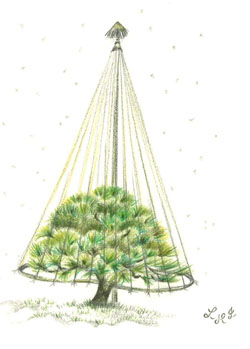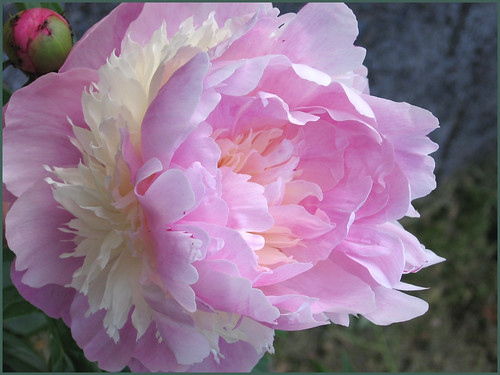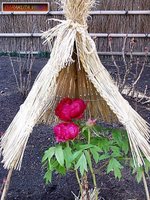. Tengu to matsu 天狗と松 / 天狗松 the Tengu pine .
. pine 松と伝説 Legends about the pine tree .
:::::::::::::::::::::::::::::::::::::::::::::::::::::::::::::::::::::::::::::::::::::::::::::::::::::
Pine (matsu)
***** Location: Japan
***** Season: Various, see below
***** Category: Plant
*****************************
Explanation
The Pine itself is not connected to any special season, but there are many other words used as kigo, using the pine as a part of it. There also various types of PINE in Japan.
First read this essay by Linda Inoki about the pine in Japan.

©
http://www.japantimes.co.jp/images/photos2005/fe20050106lia.jpg
Matsu (Pine) By LINDA INOKI
From high in the sky,
The snow making its way down
Following the pine.
By Seishi Yamaguchi, quoted in "The Essence of Modern Haiku" by Takashi Kodaira and Alfred H. Marks (Mangajin)
With the onset of winter, many Japanese gardens start to feature strange and ethereal "sculptures" made of string: These are the yukitsuri, or "snow lines." Although their purpose is to protect pine trees from heavy snow, they are so airy and attractive that they seem to invite it to fall from the skies! This practical idea has been turned into a piece of garden artistry, and even in regions where snow rarely falls, gardeners cannot resist adding these graceful touches to the winter scene.
I sketched this small pine tree with its high snow ropes in a Tokyo garden. It is a goyomatsu ( Pinus pentaphylla; Japanese white pine), which you can identify by its silvery bark and pine needles growing in groups of five. White pines are slow-growing and are popular for training into bonsai or specimen trees in the garden. Being tough, long-lived and evergreen, pine trees are important symbols of endurance and eternity in Oriental culture. With their year-round foliage, they also bridge the seasons of winter and spring, and although we live in a material world it is good to see that many people still decorate their gateways with the traditional branches of pine to greet the New Year.
The Japan Times: Jan. 6, 2005
http://www.japantimes.co.jp/cgi-bin/getarticle.pl5?fe20050106li.htm
Yukitsuri, trees in bondage.
By Alice Gordenker, Japan Times Feb. 2007
:::::::::::::::::::::::::::::::::::::::::::::::::::::::::::::::::::::::::::::::::::::::::::::::::::::

"Three friends of Winter", Pine, Bamboo and Plum
Shoo-chiku-bai 松竹梅
shoochikubai, shochikubai. Sho-Chiku-Bai
. . . CLICK here for Photos !
saikan sanyu 歳寒三友 Three Friends of Winter
. . . CLICK here for Photos !
They are an auspicious assembly used since olden times in Chinese art, later in Japanese art too. The symbolic meaning of the Pine Tree is "Long Life".
Pine trees show abundand green even in the fiercest of winter and hardly dry out, so they have been a symbol of long life in China since old times. They also represent friendship and constancy during times of advertsity. As symbol of good luck and agelessness this tree has stood in veneration and together with the bamboo and plum tree as become an expression of celebration and joy, especialy in the New Year season.
Sometimes the pine tree symbolizes one of the Chinese gods of happiness and long life, Shou Hsing.
In Japan, we have the couple of Joo (尉) and hers is Uba (媼)
"The Pine of Sumi-no-e" (住吉の松) and the Takasago Legend
. . . CLICK here for decorative Photos !
shoochikubai kazaru 松竹梅飾る (しょうちくばいかざる)
decoration of pine, bamboo and plum
kigo for the New Year
WKD : New Year Decorations (o-kazari)
. WASHOKU
Sho-Chiku-Bai on the Menu
:::::::::::::::::::::::::::::::::::::::::::::::::::::::::::::::::::::::::::::::::::::::::::::::::::::
New Year Kigo
. kadomatsu 門松と伝説 Legends about pine decorations .
Gate Decoration with Pine, kadomatsu 門松
placed one each at the gate or entrance of a home. Their size reflects the richness of the owner. They are put out on December to welcome the Deities and burnt on January 6 or 14 (matsu osame 松納め) .
..... Pines by the corners, kado no matsu 門の松
Kadomatsu and New Year Decorations ... KIGO List
鎌倉の古き宿屋の松飾り
Kamakura no furuki yadoya no matsukazari
these pine decorations
at the old inns
of Kamakura
Takahama Kyoshi, 1949
Temple Tanjo-Ji, by Gabi Greve
pine decorations, matsu kazari 松飾り
..... kazari matsu 飾り松
bamboo decorations, kazari take
Click HERE to have a look at some more photos !
..... Pulling Pine Seedlings (komatsu hiki)
- - - - -
. WKD : Kobayashi Issa 小林一茶 .
the 5th: cloudy, cold wind blowing, snow from around 4 p.m. -- a foot deep
chiru yuki ni tachiawasekeri kado no matsu
New Year's pines
alone together now
with falling snow
Tr. Chris Drake
This hokku is from 1/5 (Feb. 15) in 1804, when Issa was traveling around in the area just east of Edo. His diary states the situation in a headnote. In the 12th month people stood a pair of New Year's pines in buckets or on stands in front of their doors and gates. People with money used taller pines and also added a third crossbar pine so that it connected the tops of the two vertical pines and created a symbolic gate resembling the wood or stone torii gate at the entrance to the precincts of a Shinto shrine. Sometimes a shamanic rope or the horizontal crossbeam above the gate entrance itself served this purpose.
In Issa's time many people also put various lengths of bamboo and sometimes other kinds of limbs and flowers in with the pines. Pine trees were believed to be the tree that gods favored when they came down from the sky/other world, and these "gate pines" were regarded as invitations to the god of the new year (toshigami) to visit the house and bring good fortune to it during the new year. In fact, the shrine-gate shape of the gate pines suggests that they symbolically turned each house into a temporary shrine for the year's god and for other gods. Many people put the pines up on 12/13 and kept them up until 1/15, when they were burned in sacred bonfires under the first full moon of the new year and sent back to the invisible world of the gods.
In this hokku it has begun to snow hard, and few people walk through the dim, snowy streets, giving the pines and snow some space and time together. The pines and the falling snow somehow seem aware that they are now together with each other. It doesn't snow that much in the Edo/Tokyo area, so this may be the first time. Perhaps it's a bit like two shy teenagers who like each other and suddenly find themselves next to each other. Of course Issa doesn't know exactly how the pines and snow feel, but there is an uncanny resemblance between descending snow and the descent of various gods of good fortune at New Year's. The pines have been put up above all in order to wait for these gods and to welcome their visits, and now something is happening. Perhaps Issa wonders if the pines can sense gods drifting down in the snow. Or perhaps it's more intimate, since the snow may be falling directly onto the pines, lying on their limbs.
A couple of more versions, the first literal and the second a stab, using an aural image, at what Issa might be getting at:
New Year's pines
find themselves together
with falling snow
New Year's pines
overhear
snow falling
Here is a photo of gate pines of the types common in Issa's time:

- Chris Drake -
Translating Haiku Forum
小一尺それも門松にて候
ko-isshaku sore mo kadomatsu nite sooroo
foot-high pines
stand tall by the door
at New Year's
Tr. Chris Drake
This hokku is from the 1st month (February) of 1812, when Issa was staying in the area just east of Edo. It evokes a scene Issa saw at or around New Year's, when people stood a pair of pine trees just outside their doors. One pine was placed on each side of the door, suggesting divine gateposts down which a shamanic god (or a pair of gods) could descend, and at the houses of the rich and powerful a third pine or a string with decorations was often placed horizontally, linking the tops of the two vertical pines, a shape resembling the divine gates or torii at Shinto shrines. Thus the twin pines symbolically made each house or apartment into a temporary small Shinto shrine. Above all, the pines were set up to invite the god of the new year to make a visit to the house and bring good fortune to it during the coming year.
However, Edo and the towns around it were filled almost to bursting with poor immigrants from the country -- such as Issa -- who came to Edo to escape difficult conditions, poverty, or even starvation in their farm villages. Most of these people couldn't afford a pair of pine trees 5 or more feet tall, so they bought cheap one-foot sections of a pine limb and stood these vertically on each side of their doors using stands or small pots, often with decorations placed on them. Issa uses the term "short shaku" (equal to 99.4% of a foot) to evoke the commercial nature of these measured and precisely cut sections that poor people had to make do with at New Year's, probably because he wants to stress just how irrelevant physical length is to the spiritual value of the limbs.
Issa uses a very polite form for the verb "are" to show his admiration for the people who did what they could and stood the pine limbs in front of their door as an expression of respect for the gods and for all who pass by -- and to show his admiration for the pine limbs themselves, which are just as spiritually imposing at New Year's as the tall pine trees standing in front of the gates of large mansions. The polite verb form suggests Issa isn't writing about his own doorway but is expressing his great respect for the poor family that set up the one-foot pines that in their new context seem so tall.
Chris Drake
.................................................................................

shared by Yoshinobu Takemura FB-JOJ
warau kado ni wa fuku kitaru - 笑う門には福来る
Fortune comes in by a merry gate.
.................................................................................
observance kigo for mid-winter
matsu mukae 松迎え (まつむか)
"welcoming the pine decorations"
matsubayashi 松ばやし(まつばやし)"festival music for the pines"
kadomatsu oroshi 門松おろし(かどまつおろし)
On the 13th day of the 12th lunar month, the pine branches were cut in the local forest and brought home to make the decorations. This was accompanied with music on the way and food afterwards.
Nowadays it occurs often on the 8th day of December.
In some temples and shrines, ritual dances were also performed on this day.
:::::::::::::::::::::::::::::::::::::::::::::::::::::::::::::::::::::::::::::::::::::::::::::::::::::
SPRING KIGO
young green, wakamidori 若緑 is a general term for the pines when they start growing.
also called
green of the pine, matsu no midori 松の緑,
first green, hatsu midori 初緑
green starts to stand up, midori tatsu 緑立つ
and finally
松の芯 matsu no shin, center of the pine growing, pine candles:
kigo for late spring
matsu no SHIN can also be interpreted as the strong will of the pine (human) to keep going in adverse situations, so this expression is well loved in Japanese poetry.
© Gabi Greve
松の花 まつのはな matsu no hana, pine flowers
. . . CLICK here for more Photos !
松花粉 まつかふん matsu kafun, pine pollen
This is a growing problem in Japan these days.
:::::::::::::::::::::::::::::::::::::::::::::::::::::::::::::::::::::::::::::::::::::::::::::::::::::
松囃子 matsubayashi, music and dance performance
http://ww7.tiki.ne.jp/~agari/matubayasi-syasinn.html
http://www.city.fukuoka.jp/contents/7d14c213111/7d14c21311110.htm
お松明 おたいまつ o-taimatsu pine torch [used in the ceremony] for O-Mizu Tori ceremony

Read more about this festival here:
http://www.mahoroba.ne.jp/~vrk-nara/omizutori/shunie-e.html
:::::::::::::::::::::::::::::::::::::::::::::::::::::::::::::::::::::::::::::::::::::::::::::::::::::
SUMMER KIGO
Pine needles falling down, matsu ochiba 松落ち葉
松漁 かつお katsuo bonito [kanji literally "pine fish"]
松蝉 [まつぜみ] matsuzemi, pine-tree cicada
松葉牡丹 まつばぼたん matsubabotan portulaca / rose moss
lit. "pine-needle peony"
Portulaca grandiflora
..... hiderigusa 日照草 ひでりぐさ sun plant
:::::::::::::::::::::::::::::::::::::::::::::::::::::::::::::::::::::::::::::::::::::::::::::::::::::
AUTUMN KIGO
matsuba 松葉 pine needles
irokaenu matsu 色変えぬ松 (いろかえぬまつ) pines not changing colors
late autumn
松手入 まつていれ matsu teire,
pruning pines [literally "pine maintenance"]
kigo for late autumn
松ぼくり(まつぼくり)pinecones, pine cones
新松子 (しんちぢり) shinchijiri, new pinecones
..... 松ふぐり(まつふぐり) matsu fuguri
青松毬(青松笠) あおまつかさ aomatsukasa ao matsukasa, green pinecone
late autumn
. Matsutake 松茸 pine mushroom .
Armillaria edodes. VERY expensive.
松茸飯 matsutake meshi, rice with matsutake mushrooms, a very expensive delicacy
松虫 matsumushi, pine bug
lit. "insect in waiting", a symbol for a lady waiting for her lover.
- Matsumushi Haiku -
松虫草 matsumushi-soo, pine, bug grass
:::::::::::::::::::::::::::::::::::::::::::::::::::::::::::::::::::::::::::::::::::::::::::::::::::::
WINTER KIGO
early winter kigo
shiki matsuba 敷松葉 (しきまつば) spreading pine needles
In the garden, to protect other bulbs and moss. This would give the garden an elegant look. Especially used for tea room gardens.
. . . CLICK here for Photos !
.................................................................................
late winter kigo
yukitsuri 雪吊 (ゆきつり)supporting trees with strings
yukizuri
.................................................................................
late spring kigo
yukitsuri toku 雪吊解く(ゆきづりとく)taking down the support strings
*****************************
Worldwide use
Kiefer, Rotkiefer
****************************
Things found on the way

茂岡の神さび立ちて栄えたる
千代松の樹の歳の知らなく
Shigeoka no kamu sabitachite sakaetaru
chiyo matsu no ki no toshi no shiranaku
The pine, the tree that waits for a thousand reigns,
that flourishes and stands godly at Shigeoka, knows no year.
Manyo-Shu Poetry Collection - 紀朝臣鹿人
Haruo Shirane - Japan and the Culture of the Four Seasons
source : books.google.co.jp
:::::::::::::::::::::::::::::::::::::::::::::::::::::::::::::::::::::::::::::::::::::::::::::::::::::
. The Pine Tree Where Yoshitsune Rested .
kurakake matsu 経鞍掛松
Yoshitsune rested at this location and placed his saddle on the pine tree.
:::::::::::::::::::::::::::::::::::::::::::::::::::::::::::::::::::::::::::::::::::::::::::::::::::::

matsu pine of a Noh butai stage - 能舞台 松
. butai hajime 舞台始(ぶたいはじめ)first stage .
:::::::::::::::::::::::::::::::::::::::::::::::::::::::::::::::::::::::::::::::::::::::::::::::::::::
Matsu are a favorite for Bonsai too. Look at some nice pictures.
http://homepage3.nifty.com/plantsandjapan/page033.html
MATSU 待つ can also mean: to wait for somebody.
Here is a story about Daruma and the Pine, waiting...
http://www.amie.or.jp/daruma/Matsu-2.html
*****************************
HAIKU
僧朝顔幾死返る法の松
soo asagao ikushi ni kaeru nori no matsu
Monks and morning glories;
How many have died and returned!
The Dharma pine.
Matsuo Basho
... this verse may be in the form of hokku, but it is not really hokku. It is a religious verse, and when we try to "preach" religion in hokku, the result inevitably fails. Also, this verse requires a kind of prologue just to be understood, which compounds the problem because it cannot "stand on its own feet."
Bashô saw a great and very old pine tree at a temple. It reminded him of the story of the Chinese Daoist Zhuangzi (Chuang-tzu) about a tree that survived the years because its wood was useless. That set Bashô off on a train of thought about how many monks had come and gone, like morning glories that bloom in the dawn and die in the evening, and yet the great pine, protected on the temple grounds by the "Dharma," had survived to very old age.
Writing about such things has its place, but it does not fit hokku.
© David Coomler
Hoo no Matsu, nori no matsu, the Pine of the Buddhist Law.
. Basho at temple Taimadera
:::::::::::::::::::::::::::::::::::::::::::::::::::::::::::::::::::::::::::::::::::::::::::::::::::::
. Matsuo Basho 松尾芭蕉 - Archives of the WKD .
門松やおもへば一夜三十年
kadomatsu ya omoeba ichiya sanjuunen
pine decorations -
thinking about it, one night
feels like thirty years
Written in 延宝5年, Basho age 34.
In this year, Basho had decided to become a haikai master in Edo.
幾霜に心ばせをの松飾り
iku shimo ni kokoro Baseo no matsukazari
frost comes and goes
on the pine decoration
of my home
(tr. Gabi Greve)
kokorobase is a word play Basho uses to imply himself (Baseo), someone with a sincere heart.
How often the frost comes on the pine, the green does not change and stands there in endurance.
Written in 1686 貞亨3年, New Year
MORE - - kokoro こころ - 心 "heart", mind, soul -
. Matsuo Basho 松尾芭蕉 - Archives of the WKD .
:::::::::::::::::::::::::::::::::::::::::::::::::::::::::::::::::::::::::::::::::::::::::::::::::::::
matsu tatete sora honobono to akuru kado
putting up the pines,
dawn sky breaks,
at the gates
Natsume Sooseki
Read more Haiku here !
University of Virginia Saijiki
:::::::::::::::::::::::::::::::::::::::::::::::::::::::::::::::::::::::::::::::::::::::::::::::::::::
... ... ... ... ... Pine Candles
pine candles
on a sandy beach -
power of life
© Gabi Greve Beachflowers
xxxxxxxxxxxxxxxxxxxxxxxxxxxxx
pine candles -
day by day
they lengthen
© Linda Papanicolaou
xxxxxxxxxxxxxxxxxxxxxxxxxxxxx
浜道や砂から松の若みどり
hamamichi ya suna kara matsu no waka midori
beach raod -
from the sand emerging
young green
Choo Mu 蝶 夢(died 1795)
This haiku captures the same mood as I experienced in Yonago in 2004. This kigo usually discribes a scene of light and warmth and hope.
xxxxxxxxxxxxxxxxxxxxxxxxxxxxx
The following haiku where kindly suggested by Etsuko Yanagibori.
cherrypoetryclub
ame no ka ni tachimasarikeri matsu no shin
fragrance of rain -
growing up eagerly,
the pine candles
Watanabe Suiha (1882 - 1946)
.....
Musashino no tori kuru matsu no shin mugen
birds of Musashino plain
coming to the pine candles -
infinity
Hasegawa Kanajo (1887 ~ 1969)
.....
赤松は芯 黒松は花 こぼしけり
Akamatsu wa shin Kuromatsu wa hana koboshikeri
Red pine candles
Black pine flowers
so abundantly
Fujita Akegarasu 藤田あけ烏
http://www.d2.dion.ne.jp/~t_katou/goroku0.html
*****************************
Related words
***** komo こも【薦】straw mats around the tree trunks
to prevent insects to hurt the tree during winter time.
:::::::::::::::::::::::::::::::::::::::::::::::::::::::::::::::::::::::::::::::::::::::::::::::::::::

The Pine Tree of Priest Rennyo at Morinomiya
(Morinomiya Rennyo-matsu)
Utagawa Yoshitaki (1841-1899)
- from the series "One Hundred Views of Osaka" (Naniwa hyakkei), 1860.
— Museum of Fine Arts, Boston.
Saint Rennyo 蓮如
(1415-1499) 8th abbot of the Jōdo Shinshū sect. Temple Hongan-Ji
Rennyo-Ki 蓮如忌 (れんにょき)Memorial Day
Yoshizaki moode 吉崎詣(よしざきもうで)Yoshizaki pilgrimage
. WKD : Memorial Days .
. Honganji 本願寺 Hongan-Ji, Hongwanji .
Kyoto
. pine 松と伝説 Legends about the pine tree .
. Tengu to matsu 天狗と松 the Tengu pine .
Legends
:::::::::::::::::::::::::::::::::::::::::::::::::::::::::::::::::::::::::::::::::::::::::::::::::::::
[ . BACK to WORLDKIGO . TOP . ]
[ . BACK to DARUMA MUSEUM TOP . ]
- #matsupine #pinematsu #kadomatsu -
:::::::::::::::::::::::::::::::::::::::::::::::::::::::::::::::::::::::::::::::::::::::::::::::::::::




























